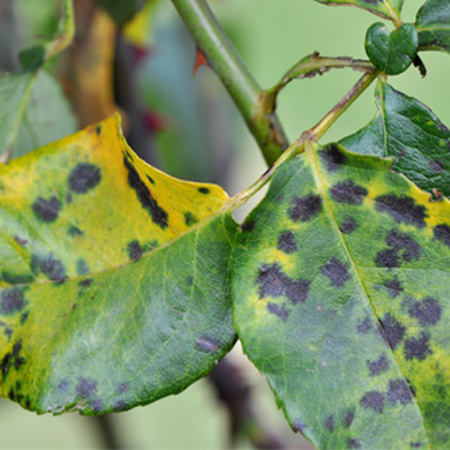Black Spot
BackBlack spot is a fungal disease that affects roses all over Australia. As the name suggests it causes black spots to appear on the leaves. These spots have blurred edges and appear randomly on leaves where the fungal spores originally landed. Infected leaves yellow and fall off. In severe cases black spot can attack the stems of the roses and cause dieback.
This disease spreads quickly and can result in complete defoliation. Not surprisingly plants are severely weakened resulting in fewer flowers and less growth. In this stressed state they are also more vulnerable to other pests and diseases.
Black spot thrives in hot, humid weather and some rose varieties are more susceptible than others. If you have a plant that is always severely affected it may be best to replace it with a variety that is known to be resistant to black spot.
Plants Attacked
Black spot is a very common fungal disease of roses. Some varieties are less susceptible but just about all the popular ones seem to get it.
Organic Control Methods for Black Spot
Best results are obtained by undertaking both the cultural and spray methods.
Cultural Methods
- Ensure the rose receives at least 6 hours of direct sunlight every day
- Ensure good air circulation around the bush
- Clean up fallen leaves regularly as these can be a source of reinfection
- Water in the morning as residual water will evaporate faster than in the evening
- Avoid watering the foliage
- Feed regularly with an organic fertiliser as roses are hungry plants
- Regular application of OCP eco-seaweed will stimulate stronger healthier growth
Spray Methods
- Apply OCP eco-fungicide every 7-10 days at the first sign of disease outbreak. Leaves already infected cannot be saved but the spray will create a protective coating over leaves to prevent new infection occurring.
- Include OCP eco-seaweed into the spray solution to strengthen plant tissue and make it harder for the fungus to penetrate into the leaves.
HANDY HINT: We recommend adding a little OCP eco-oil (2ml per litre) to the eco-fungicide or eco-rose solution to help it stick and spread better over the foliage. If you have an insect problem at the same time then increase the eco-oil rate (5-10ml per litre) to create a combined organic insecticide and fungicide spray. Too easy.
Read our rose care tips to learn more about growing beautiful organic roses.



